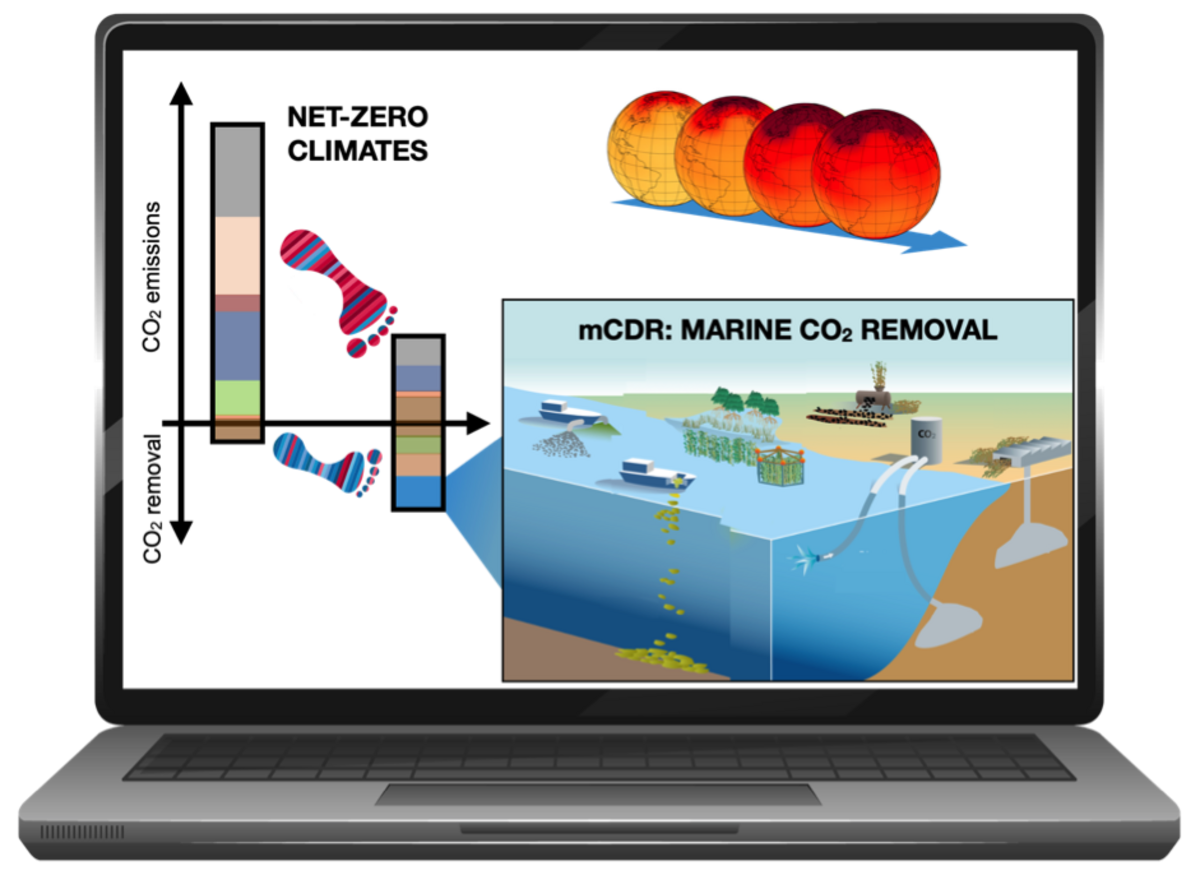(Andreas Oschlies, Markus Schartau)
Even with ambitious climate mitigation policies following net-zero greenhouse gas (GHG) claims, humanity is expected to release residual amounts of carbon dioxide (CO2) or other GHG emissions in the future, thereby continuing to drive global warming. Carbon Dioxide Removal (CDR) options - like bioenergy combined with carbon capture and geological storage, ocean alkalinity enhancement, or ecosystem management and expansion - offer the possibility to support emission reduction efforts and offset remaining GHG emissions, thereby enabling net-zero targets. Furthermore, CDR is key to providing net-negative emissions to reduce atmospheric CO2 concentrations in order to reverse a carbon budget or temperature overshoot.
This group aims to further our understanding of the Earth systems response to such (partly novel) anthropogenic activities, to net-zero (i.e. no/low forcing) and to overshoot (i.e. negative anthropogenic forcing) scenarios using Earth system models of various complexities (FOCI, UVic ESCM 2.9 & 2.10), as well as multi-model ensembles from CMIP (CDRMIP, ZECMIP). Through interdisciplinary collaboration, we contribute to comprehensive assessment activities for CDR options.
Research foci include:
Contributors
- Nadine Mengis: works on comprehensive assessment frameworks for carbon dioxide removal methods in the context of Germany with a focus on net-zero Germany options; Quantification of uncertainty concerning the temperature response to net-zero and overshoot pathways including socio-economic and earth system dynamic uncertainties (FOOTPRINTS [project lead], ASMASYS [project lead], RESCUE, GESAMP WG41)
- David Keller: Earth system model-based assessments of carbon dioxide removal (negative emissions) approaches, especially ocean-based ones. Particularly in understanding feedbacks between biogeochemical cycles and the climate, as well as the impacts upon marine ecosystems and biogeochemistry. (OceanNETs [project coordinator], RESCUE, ASMASYS, sea4soCiety, OCEAN ALK-ALIGN, RETAKE, CDRMIP]
- Andreas Oschlies: Co-chair CDRmare, Earth system modelling with models of medium complexity (RETAKE [project coordinator], ASMASYS, CDRSynTra, SeaO2-CDR, GESAMP WG41)
- Markus Schartau: Evaluation of the CDR efficiency of different scales and frequencies of ocean alkalisation at local sites and simulation of the corresponding potential responses of plankton dynamics (OceanNETs)
- David Hohn: working with multi model ensembles of zero emissions scenarios to determine the size and uncertainty of the zero emissions commitment (ZEC) (FOOTPRINTS)
- Giang Tran: works on the assessment of the parametric uncertainties in UVic, and the effectiveness and potential side effects of CO2 removal measures (CDR) in mitigating the effects of climate change on marine ecosystems (RESCUE)
- Hao-Wei Wey: works on assessing the effects of both land- and ocean-based CDR methods on climate and carbon cycle with FOCI (CDRSynTra)
- Margarita Liadova: works on parametrisation of coastal vegetated systems (CVEs) in FOCI to simulate and assess their ability of carbon sequestration under different climate scenarios (Sea4Society)
- Wanxuan Yao: contributing to the design of an assessment framework to evaluate marine carbon dioxide removal (CDR) options for Germany (ASMASYS)
- Sandy (Alexandra) Avrutin: Using the Flexible Ocean and Climate infrastructure (FOCI) to examine monitoring, reporting and verification techniques for marine-based CDR (SeaO2-CDR)
- Estela Monteiro: investigation of climate & temperature stabilisation forcing scenarios, focusing on the contribution of nonCO2 components (FOOTPRINTS)
- Neha Mehendale: carbon dioxide removal potential and Earth system impacts of ocean alkalinity enhancement using the Flexible Ocean and Climate Infrastructure (FOCI) earth system model (RETAKE)
We seek to conduct responsible research using models. All of the data and code used in our studies is publicly available and follows good data management practices. We strive to indicate the assumptions built into our models and the process by which these assumptions were reached. We also strive to make explicit current limits on our ability to simulate the climate and CDR approaches. Those of us that conduct research on CDR would like to note that we view CDR as a complement, never a substitute, for large reductions in greenhouse gas emissions. For more information on responsible CDR research, which we aspire to adhere to, see A Code of Conduct for Marine Carbon Dioxide Removal.
If you are interested in collaborations or joining the group please do not hesitate to get in touch (nmengis@geomar.de)!



